Carboxylic Acids and Derivatives - Properties and Reactivity of Carboxylic Acids (A-Level Chemistry)
Properties and Reactivity of Carboxylic Acids
Carboxylic Acids
Structure of Carboxylic Acids
Carboxylic acids are molecules with a carboxyl functional group RCOOH.
The general structural diagram for carboxylic acids is:
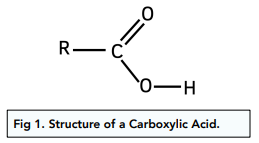
The images below show skeletal diagrams of common carboxylic acids with their IUPAC names.
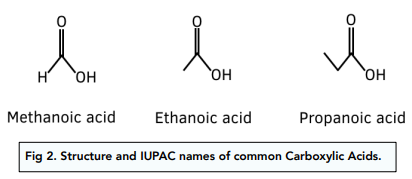
IUPAC Naming of Carboxylic Acids
Here are some useful rules to bear in mind when naming for carboxylic acids:
- The suffix for a carboxylic acid is always -oic acid. Regardless of whether there is more than one type of functional group in the molecule. The name of a molecule with two carboxylic acid functional groups will have a suffix -dioic acid.
- The carboxylic acid functional group is always found at the end of the molecule. The carbon atom with the carboxylic acid functional group is always taken as carbon atom number 1.
- The prefix is derived from the longest parent alkane chain.
- When the carboxylic acid functional group is attached to a benzene ring, the suffix -carboxylic acid is used. For example, benzenecarboxylic acid.
Worked Example: Write the IUPAC name for this molecule
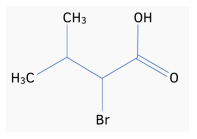
Answer: 2-bromo-3-methylbutanoic acid
Explanation: Carbon atom 1 is the one with the -COOH group. Bromine is on carbon atom 2, hence “2-bromo”. There is a methyl group on C atom 3, and there are four carbon atoms in the chain, hence butanoic acid.
Worked Example: Draw the skeletal diagram for 2- hydroxybenzenecarboxylic acid
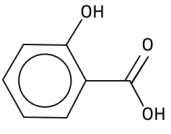
Answer:
Explanation: The carboxylic acid group is attached to carbon atom 1 in the benzene ring. “Hydroxy” is the prefix used for an alcohol group where there is another functional group present. This is placed on C atom 2.
Predicting Properties of Carboxylic Acids
You need to apply your understanding of intermolecular forces to the structure of carboxylic acids and use this to predict their properties.
There is an O-H bond, which means all carboxylic acids will have hydrogen bonding. In addition the C=O bond forms a permanent dipole-dipole. Therefore between two carboxylic acid molecules, two hydrogen bonds will form as shown.
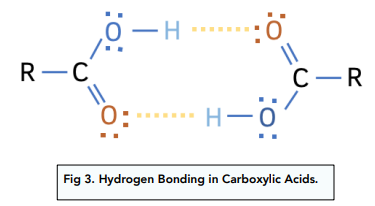
The result of this is that they will have much higher boiling points compared to equivalent alcohols. In addition, carboxylic acids will form hydrogen bonds with water and the smaller molecules are completely soluble in water.
Carboxylic Acids as Acids
Carboxylic Acids as Weak Acids
- An acid is a proton donor. The greater the ability of a molecule to release protons (H+ ions) the higher its acidity.
- Carboxylic acids are weak acids. This is because they only partially ionise to release hydrogen ions. For example in one mol dm⁻³ solution of ethanoic acid, only four in one thousand molecules dissociate to
release hydrogen ions.
CH₃COOH(l) ⇌ CH₃COO⁻ (aq) + H⁺(aq)
- The O-H bond breaks in the dissociation. The degree of ionisation depends on how stable the carboxylate ion is to accepting the H⁺ ion back.
- Electrons between the C and O atoms are delocalised. In reality the two C-O bonds in the carboxylate ion are the same length and strength, suggesting the electrons between the C and O atoms are delocalised, as shown in the diagram below. This means that as the negative charge is spread over the molecule, it makes it more stable and harder to accept an H⁺ ion back.
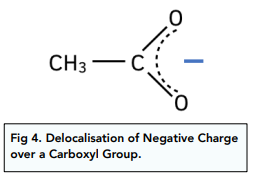
The deloacalisation of electrons around the -COO- group, results in carboxylic acids being more acidic than other compounds with -OH groups such as alcohols (pKa = 16 approx.) and phenols (pKa = 10 approx)
Worked Example: Methanoic acid is a stronger acid (pKa = 3.75) compared to ethanoic acid (pKa = 4.76). Use the structure of each to explain why. (4 marks)
Answer:
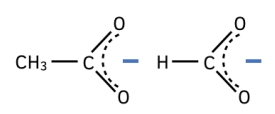
In the ethanoate ion, there is a methyl group is attached to the C atom. The methyl group has a more positive inductive effect than the H atom attached to the C in the methanoate ion. (1)
The methyl group pushes electron density towards the delocalised area of negative charge (1), Increasing this area of negative charge, and makes it more susceptible to accepting a H⁺ ion back (1).
This reduces the acidity. This does not happen with methanoic acid, and the H⁺ ions released are less readily accepted back by the methanoate ion, as there is less relative delocalised negative charge.(1)
Comparing Acidities
The strength of a carboxylic acid depends on what groups are bonded to the C atom next to the carboxyl group.
These groups can either be:
- Electron withdrawing – Attract electron density towards themselves away from the carboxyl group. These include highly electronegative halide atoms such as chlorine.
- Electron donating – Donate negative charge towards the carboxyl group. These include alkyl groups. The longer the alkyl chain, the stronger the effect.
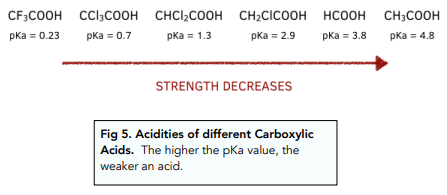
- If the the carboxyl group is bonded to electron withdrawing groups, its acidity increases. This includes The O-H bond is weakened further in the undissociated acid molecule and the delocalisation of negative charge on the -COO- group in the carboxylate ion is further extended so that it becomes more stable.
- If the the carboxyl group is bonded to electron donating groups, its acidity decreases. The O-H bond in the undissociated acid molecule is strengthened and the charge density of the -COO- group in the carboxylate ion increases, so that it accepts H+ more readily
Reactions of Carboxylic Acids as Weak Acids
As with all acids, carboxylic acids will react with strong bases to form carboxylate salts. Methanoic acid forms methanoate salts; ethanoic acid form ethanoate salts and so on.
All carboxylic acids are strong enough to release carbon dioxide gas from carbonates. The carbon dioxide can be bubbled through calcium hydroxide solution (limewater) which will turn cloudy as a precipitate of calcium carbonate forms.
Reaction of Carboxylic Acids
Reduction
Carboxylic acids can be reduced back to a primary alcohol by using lithium tetrahydroaluminate (LiAlH₄)⁻ a powerful reducing agent – in dry ether.
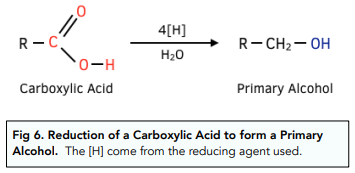
Oxidation
Most carboxylic acids cannot be further oxidised.
Methanoic acid and ethanedioic acid are two exceptions.
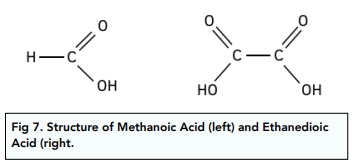
Both methanoic and ethanedioic acid be oxidised to carbon dioxide by adding an acidified solution of KMnO₄.
HCOOH + [O] → CO₂ + H₂O
HOOCCOOH + [O] → 2CO₂ + H₂O
Methanoic acid will also be oxidised by Fehling’s solution, Tollen’s reagent, or acidified solution of K₂CrO₇.
Acyl Chloride Formation
If a carboxylic acid is mixed with phosphorous (V) chloride, phosphorous (III) chloride or thionyl chloride (SOCl₂), the -OH group gets replaced by a Cl atom to form an acyl chloride. You will learn more about these type of compounds in the next tutorial.
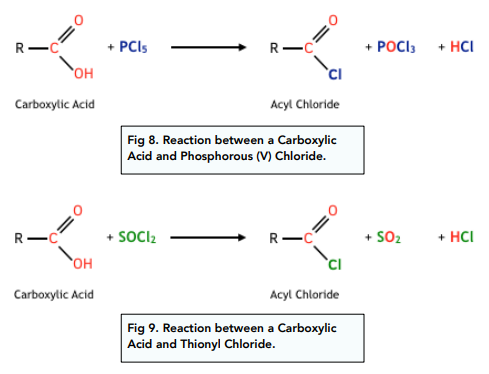
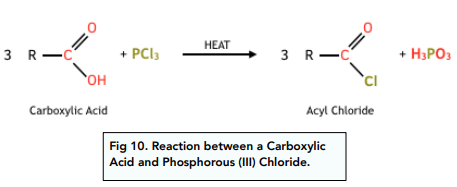
Condensation Reactions
Carboxylic acids react with alcohols in the presence of a strong acid catalyst (e.g. concentrated sulfuric acid) to form esters and water.
The reaction is reversible and reaches an equilibrium mixture. As water is produced, this is a condensation reaction.
Example: Making an Ester
Ethanoic acid + ethanol ⇌ ethyl ethanoate + water
CH₃COOH + CH₃CH₂OH ⇌ CH₃COOCH₂CH₃ + H₂O
The C-O bond in the acid breaks releasing O-H. The O-H bond in the alcohol breaks, releasing -H. The O-H from the acid and H from the alcohol combine to form water.
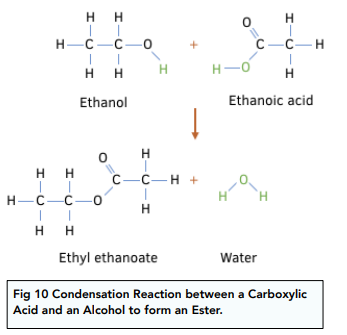
The ester formed is less soluble in water than the carboxylic acid or alcohol, and has the lowest density. It can be separated using a separating funnel.
In addition, the ester has the lowest boiling point of any substance in the equilibrium mixture and can be distilled off to purify it.
Carboxylic acids and derivatives are a class of organic compounds that contain a carboxyl group (-COOH) as the functional group. Some common examples include acetic acid (found in vinegar), formic acid (found in ant stings), and citric acid (found in citrus fruits).
Carboxylic acids have several characteristic properties, including:
Sour taste
Pungent, unpleasant odor
High boiling points (compared to similar-sized alkanes)
Poor electrical conductivity
Reactivity with active metals to form salts and hydrogen gas
Carboxylic acids react with active metals, such as sodium and potassium, to form salts and hydrogen gas. The reaction is exothermic, releasing heat energy.
The reaction between a carboxylic acid and a base is called a neutralization reaction. This reaction produces a salt and water.
Derivatives of carboxylic acids include esters, amides, and acid chlorides. These compounds are formed by replacing one or more hydrogen atoms in the carboxylic acid with a different group.
Carboxylic acids react with alcohols in the presence of a catalyst to form esters. This reaction is called esterification. The ester molecule has the characteristic carboxyl group (-COO-) and a hydrocarbon group (-R) attached to the oxygen atom.
Esters have several characteristic properties, including:
Sweet, fruity odor and flavor
Low water solubility
Low boiling points
High vapor pressure
Carboxylic acids react with amines in the presence of a catalyst to form amides. This reaction is called amidation. The amide molecule has the characteristic carboxyl group (-COO-) and an amine group (-NH2) attached to the nitrogen atom.
Amides have several characteristic properties, including:
Solubility in polar solvents (such as water)
Reactivity with strong acids to form salts and release a carboxylic acid
Reactivity with strong bases to form amines
Carboxylic acids react with acid chlorides in the presence of a catalyst to form anhydrides. This reaction is called anhydride formation. The anhydride molecule has two carboxyl groups (-COO-) attached to adjacent carbons.





Still got a question? Leave a comment
Leave a comment